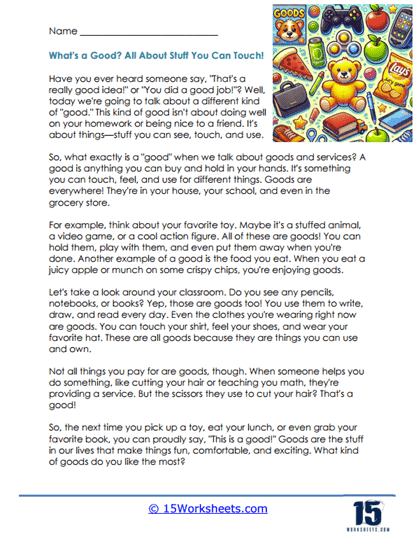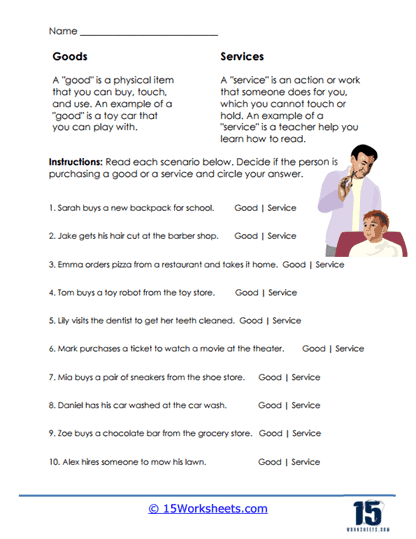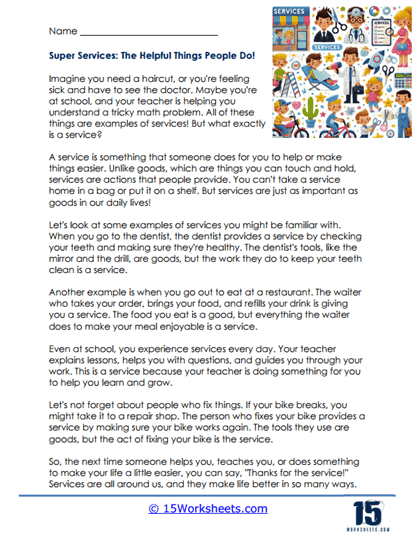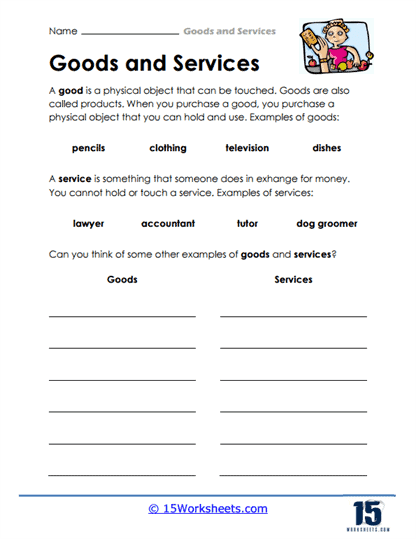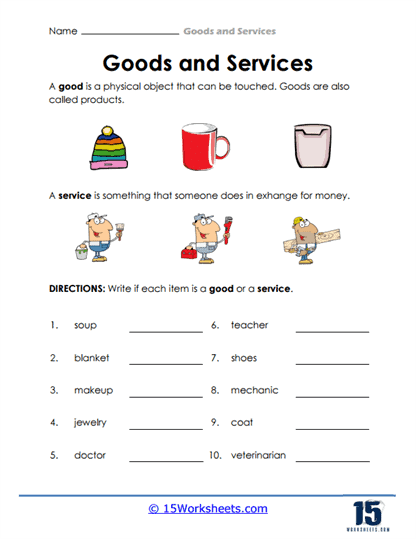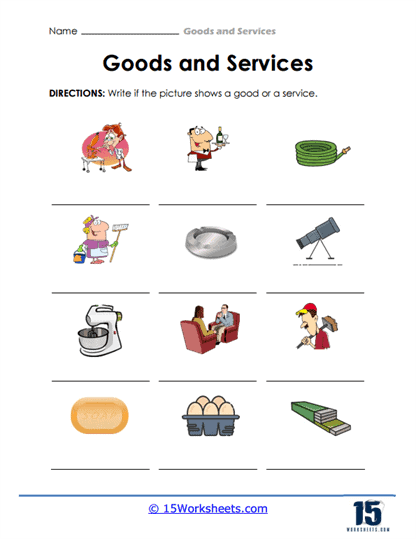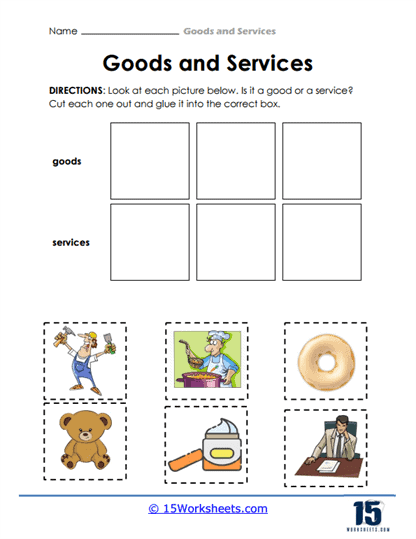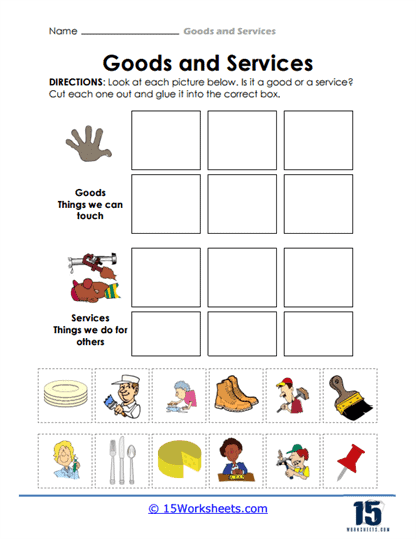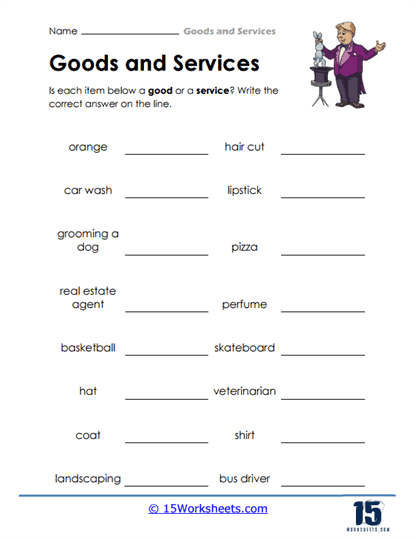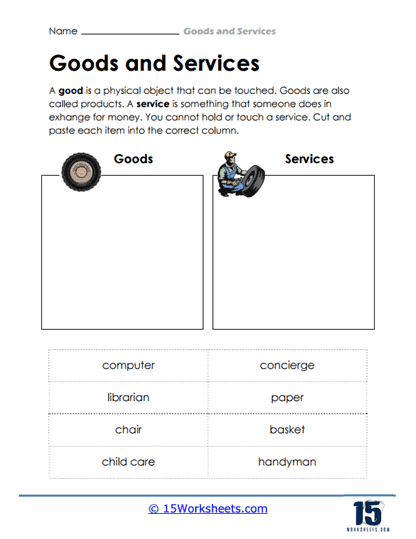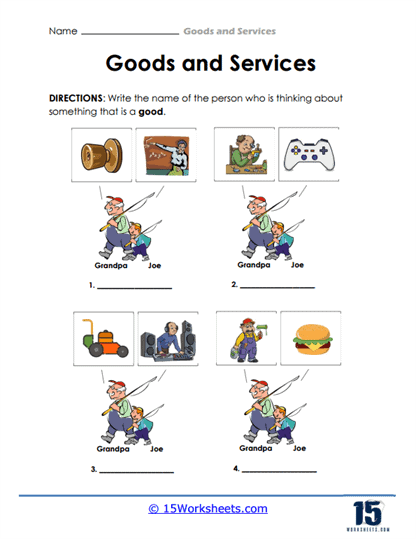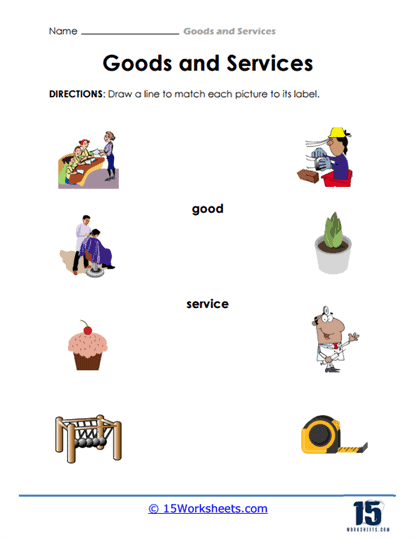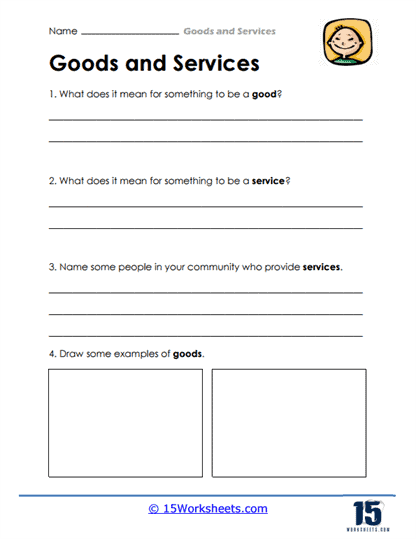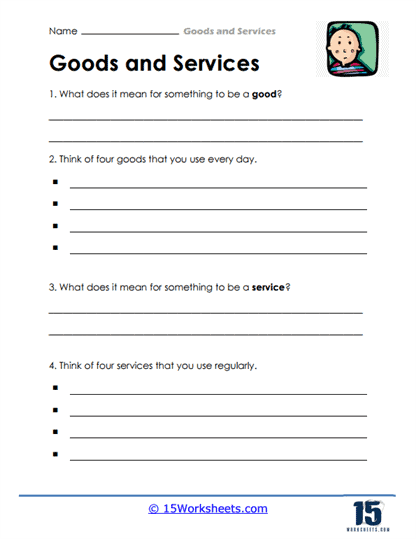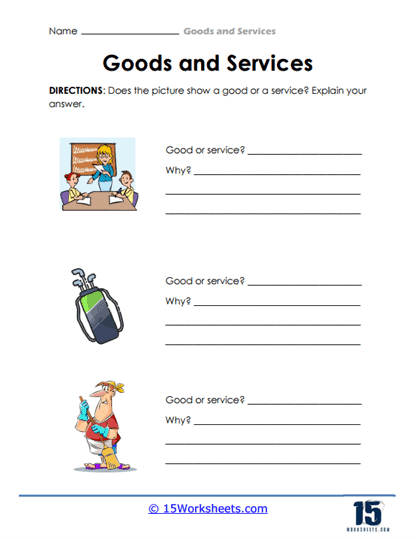Goods and Services Worksheets
About These 15 Worksheets
This collection offers a variety of interactive worksheets that cater to young learners, providing them with a hands-on approach to distinguish between goods-physical items that can be touched, seen, and used-and services-actions or activities done for someone else. These worksheets are perfect for classrooms, homeschooling environments, and supplemental learning at home.
The series includes a wide range of activities that encourage active participation and critical thinking. For instance, the first worksheet introduces the concept of goods with a relatable explanation about items that can be bought, touched, and used, such as toys, food, and clothing. The concept of services is explained as actions like haircuts, teaching, or repairs, which cannot be touched but are equally valuable.
Students are then guided through scenarios where they identify whether a person is purchasing a good or a service. These scenarios include everyday activities like buying a backpack, getting a haircut, or having a car washed. By circling the correct answer, students reinforce their understanding in a practical context.
Another set of worksheets challenges students to classify items and actions into the correct category-goods or services. This matching activity sharpens their ability to differentiate between tangible products and intangible services. It also introduces them to new vocabulary, expanding their knowledge of common goods and services in their community.
For younger learners, the collection includes cut-and-paste activities where students physically sort images into the categories of goods and services. This tactile approach not only makes learning fun but also helps to reinforce the differences between goods and services through hands-on interaction. These worksheets are particularly effective in helping visual and kinesthetic learners grasp the concepts.
To further deepen understanding, some worksheets encourage creative thinking by asking students to draw examples of goods and services they use in their daily lives. This activity not only reinforces the lesson but also personalizes learning, allowing students to relate the concepts to their own experiences.
In addition to standard exercises, the collection includes story-based scenarios where students determine whether characters in a narrative are engaging with goods or services. This storytelling approach helps to contextualize the concepts, making them more relatable and easier to understand.
Students are also provided with exercises that require them to identify goods and services through picture recognition. These worksheets present images of various items and actions, and students must label them correctly as either a good or a service. This activity is excellent for younger students who are still developing their reading skills, as it relies heavily on visual learning.
The collection also includes worksheets that ask students to think about the goods and services their families use. This type of activity promotes discussions at home and helps students connect what they learn in the classroom with real-world applications. Other worksheets within this collection may include crosswords and word searches that focus on goods and services vocabulary, true or false statements to test comprehension, and fill-in-the-blank exercises to reinforce key concepts. These diverse activities ensure that students of various learning styles can engage with the material effectively.
All worksheets in this collection are available in PDF format, making them easy to view, download, and print. This ensures that teachers, parents, and homeschoolers can conveniently access the materials, whether they need to prepare lessons in advance or require quick, engaging activities for students.
What Are Goods and Services?
In economics, the concept of goods and services is fundamental to understanding how economies function and how resources are allocated to meet the needs and wants of individuals and societies. Goods and services represent the outputs of economic activity and are the means by which people satisfy their desires and requirements.
Understanding Goods
Goods are tangible items that can be seen, touched, and owned. They are physical objects that can be produced, consumed, and used to satisfy human wants and needs. Goods can be classified into two main categories: consumer goods and capital goods.
Consumer goods are items that are intended for personal use by consumers. These include everyday products like food, clothing, electronics, furniture, and toys. Consumer goods are further divided into durable goods, which last for a long period of time (such as cars and appliances), and nondurable goods, which are consumed quickly (such as food and paper products).
Capital goods, on the other hand, are goods used to produce other goods and services. These include machinery, tools, and buildings used by businesses to create products. Capital goods are essential for economic growth because they enable the production of more goods and services in the future.
Goods can be stored, inventoried, and transported from one location to another. When you purchase a good, you obtain ownership of a physical object that you can use, store, or resell. The production and consumption of goods are key components of economic activity, as they involve the transformation of raw materials into finished products through manufacturing processes.
Understanding Services
Services, in contrast to goods, are intangible activities or benefits provided by one party to another. They cannot be touched, held, or stored. Instead of obtaining a physical product, consumers receive a value or experience from the service provider. Services are characterized by their intangibility, perishability, and inseparability.
Intangibility means that services do not have a physical presence. For example, when you go to a restaurant, you receive the service of being served food and drinks, but you do not take home the service itself-only the food and the experience.
Perishability refers to the fact that services cannot be stored or saved for later use. If a service is not used when it is available, the opportunity to benefit from it is lost. For example, a missed doctor’s appointment or an empty seat on a flight represents a lost service that cannot be recovered.
Inseparability means that the production and consumption of services occur simultaneously. Unlike goods, which can be produced in one location and consumed in another, services are often delivered and consumed at the same time. For instance, a haircut is provided by a barber and consumed by the customer in real-time, making the service inseparable from the service provider.
Examples of services include healthcare, education, transportation, entertainment, financial services, and personal care. When you pay for a service, you are compensating the service provider for their time, expertise, or effort rather than purchasing a physical product.

